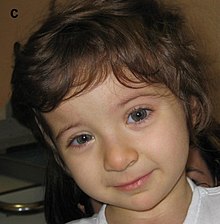Rubinstein-Taybi Syndrome
| Classification according to ICD-10 | |
|---|---|
| Q87.2 | Congenital malformation syndromes with predominant involvement of the extremities (including Rubinstein-Taybi syndrome) |
| ICD-10 online (WHO version 2019) | |
The Rubinstein-Taybi syndrome ( RTS ) is a genetic disorder that is associated with moderate mental retardation and physical abnormalities. The syndrome was first described in a study in 1957. The namesake Jack Herbert Rubinstein and Hooshang Taybi first described this syndrome in 1963.
The syndrome is not to be confused with Taybi syndrome , a form of oto-palato-digital syndrome .
frequency
The general frequency ( incidence ) is 1 in 120,000. Since only studies on children in dormitories were carried out up to the 1980s, there are very different data on this in the literature. RTS is often not diagnosed or only diagnosed in the teenage years, as the variants of the appearance are very large. It also often happens that the children have no characteristic facial features and are only very slightly mentally disabled.
Appearance and physical characteristics
The Rubinstein-Taybi syndrome is associated with different degrees of intellectual disability, for which an IQ below 50 is usually determined, with a range from 17 to 86.
In addition, there are often a number of typical physical characteristics: The head is relatively small with a wide eye relief and heavy or very high eyebrows, as well as strabismus and refractive errors , which is why glasses must often be worn. The nose appears accentuated, the nasal bridge is extended downwards. Sometimes there is a reddish birthmark on the forehead. The ears can be set low and abnormally shaped. In a high percentage of those affected with a narrow and high palate , the premolarization of the canines and incisors is evident in the form of “claw bumps”.
In terms of stature, those affected tend to be of short stature with a bent spine , vertebral anomalies and a small, crooked hip . In addition, there is a high elasticity of the joints and a stiff, unsafe gait. Often there is also increased body hair and noticeably broad, often kinked thumbs and big toes . Although the fine motor functions are less influenced, differentiated handling is made more difficult by broad thumbs.
Common malformations of internal organs are water sac kidneys , but also renal agenesis and heart defects, namely persistent ductus arteriosus , ventricular septal defect and pulmonary stenosis .
Differential diagnosis
The Floating Harbor Syndrome and the Mowat Wilson Syndrome are to be distinguished .
root cause
In Rubinstein-Taybi syndrome, gene mutations of the CBP gene are found in 10–25% microdeletion on the short arm of chromosome 16 [16p13.3) and of the p300 gene on the long arm of chromosome 22 (22q13.2)
behavior
Behavioral abnormalities can already be found in infancy. The children are restless, difficult to feed and prone to colds . While language understanding is relatively well developed, language development is clearly disturbed and noticeably slowed down. Older children appear anxious and busy and are difficult to fixate on activity. On the other hand, they are definitely sociable, friendly and affectionate. Learning progress is achieved through imitation.
advancement
When dealing with those affected, clearly structured situations help to avoid overstimulation and thus to improve attentiveness . Motor activities are supported and improved by suitable measures, such as psychomotor exercise treatment . In order to adequately satisfy the emotional needs, social reinforcers and intimate relationships are of great importance. Sign language is also used in communication as some children do not speak.
literature
- Marga Hogenboom: Understanding people with intellectual disabilities better . Ernst Reinhardt GmbH & Co KG Verlag, Munich 2003.
- Gerhard Neuheuser: Syndromes with people with intellectual disabilities . Lebenshilfe Verlag, Marburg 2004.
